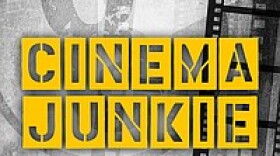LEDE: Quentin Tarantino’s new western The Hateful Eight opens on Christmas Day in 70mm. But KPBS film critic Beth Accomando says that it’s the performances and not the format that make this film worth seeing. The Hateful Eight opens with Samuel Jackson trying to hitch a ride to escape an oncoming blizzard. CLIP You got room for one more. He gets the ride and the stagecoach brings him, a bounty hunter, a woman wanted for murder and a supposed sheriff to Minnie’s haberdashery. There they meet four more unsavory characters to bring us to the grand total of Quentin Tarantino’s “Hateful Eight.” Although the film has the outward trappings of a western it turns into something more like a claustrophobic murder mystery. CLIP One of these fellas is not what he says he is. The Hateful Eight is a gorgeously shot film about an ugly situation, and what proves most memorable are the performances of Kurt Russell and Jennifer Jason Leigh. Beth Accomando, KPBS News.
Companion viewing
"The Good, the bad, and the Ugly" (1966)
"Reservoir Dogs" (1992)
"Kill Bill, Vol. 2" (2004)
"Bone Tomahawk" (2015)
Quentin Tarantino’s new western "The Hateful Eight" opens on Christmas Day in 70mm. But it’s the performances and not a resurrected format that make this film worth seeing.
A love-hate relationship with Tarantino
Tarantino is a filmmaker who loves movies, all kinds of movies, and with a passion so fierce that he could probably talk about them non-stop from now until his dying breath. I admire that passion and it is often times infectious.
Each of Tarantino’s films have paid homage to something in cinema that he loves.
Initially, he was reticent to admit what specifically was influencing him. When “Reservoir Dogs,” his first feature film, came out in 1992 fans of Asian cinema called it a rip-off of Ringo Lam’s “City on Fire” (1987). The Hong Kong film was hard to find outside of fan bootlegs and Tarantino was initially reluctant to acknowledge its influence. Tarantino was young and didn’t yet have the confidence in his ability to rip something off and make it his own.
“City on Fire” was clearly an influence and a great film in its own right. Tarantino used it as a blueprint for “Reservoir Dogs” but he made the film completely his own and investing it with his own creative flourishes.
But as Tarantino gained confidence (very quickly and now some would say he’s overly so) he realized that with each film he could introduce not just his cast and crew to some favorite film or genre of his, but also a mainstream audience. He could resurrect forgotten films like “Lady Snowblood” with “Kill Bill, Vol. One,” or reimagine the spaghetti western film “Django” as a Blaxploitation film “Django Unchained.” And because these films influenced his films, his fans would seek these films out.
He also had a knack for using actors that people had written off or had stereotyped and made us see them with new eyes – John Travolta in “Pulp Fiction,” Robert Foster and Pam Grier in “Jackie Brown,” Kurt Russell in “Death Proof,” to name a few.
In many ways, Tarantino has proven as much a film preservationist as Martin Scorsese but he has done so simply by inspiring people to seek out films and genres that might have otherwise been forgotten or pushed aside.
For all this I love Tarantino. And I do love his films. They are fueled by a pure and ferocious passion for making movies that I find irresistible. Even when flawed, they are always fun to watch for the writing, the characters, and the energy he brings to the screen.
What I hate about Tarantino, though, is that he can be his own worst enemy. When critics attack him for something (most recently, “Django Unchained” stirred a lot of controversy for its depiction of slavery and use of the “N” word), his film should be his only defense. When he starts to defend himself he sometimes just makes things worse by being flippant or trying to appear cool. And yes his over-confidence can sometimes be difficult to defend.

Now "The Hateful Eight"
I say all this as a prologue to set up how I went into “The Hateful Eight.” My excitement level was high. Tarantino had gotten Ennio Morricone, the iconic composer for so many of Sergio Leone’s spaghetti westerns, out of semi-retirement to score his new western and that was something I eagerly awaited. He looked to be returning to spaghetti western territory (something he had dabbled with in “Kill Bill, Vol. 2”), which was cause for joy. And he was bringing together a fine cast including the much-underappreciated Kurt Russell. And to top it all off he was shooting in Panavision Ultra 70mm and forcing The Weinstein Company to get a hundred theaters to play his film on FILM. Wow! I admired that he was able to use his clout to achieve his film purist dream of getting “The Hateful Eight” in cinema on 70mm.
So I went into the screening ‘”The Hateful Eight” with high expectations and that’s never fair to a film. And I came out a bit disappointed. I felt like a teacher who knew her unruly but smart student was capable of better.
Let me set up a little about the story before I explain my reaction and what I love and hate about the film. “The Hateful Eight” opens with Samuel Jackson (a Tarantino regular) trying to hitch a ride to escape an oncoming blizzard. He gets the ride and the stagecoach brings him, a bounty hunter (Kurt Russell and his fabulous moustache), a woman wanted for murder (Jennifer Jason Leigh), and a supposed sheriff (Walton Goggins) to Minnie’s Haberdashery. There they meet four more unsavory characters to bring us to the grand total of Tarantino’s “Hateful Eight.”
Adjusting expectations
Here’s where I had to adjust my first expectation. Because Tarantino had been talking up his use of 70mm and that he had Morricone doing the score, I was expecting a Sergio Leone style western epic. But while the film has all the outward trappings of a western it turns into something more like a claustrophobic Agatha Christie murder mystery.
Okay, that’s kind of cool. Tweaking expectations can be a good thing. But here’s the problem. Tarantino had also been talking up doing his film like a 1960s roadshow where you get an overture, an intermission, and ten minutes of extra footage. Just like you got for “Ben-Hur,” “The Sand Pebbles,” The Battle of the Bulge” and “Gone with the Wind.” But things like an overture and an intermission just seem slapped on; they don’t fit his small interior western that takes place almost exclusively in one location in a very short space of time. All the films he mentioned as roadshow pictures were big sprawling epics in which the overture gave us a preview of all the emotions and action to come, and where the intermission gave us a break from the scale of the film and marked a shift in the story. I wish Tarantino had had this roadshow idea back when he made "Kill Bill." Now that film merits a big presentation and an intermission!
But “The Hateful Eight” overture reveals Morricone’s most conservative score that doesn’t suggest much emotional range in the picture to come, and the intermission proves to be a moment when Tarantino decides to inject himself, as narrator, into the film for what amounts to a storytelling gag that feels very familiar in terms of Tarantino’s bags of tricks.
Plus, the film’s near three-hour length feels padded for a story of this kind. There are times (especially an extended conversation where Tarantino again insists on repeated use of the “N” word for no other reason that he thinks it’s cool that he can be a white director that can get away with it) where I just felt like it was Tarantino writing dialogue that he loved to hear. And he seems to become so enraptured with the sound of his own writing that he misses a few plot holes, things that might be forgivable in a spaghetti western but “facts” that are harder to ignore in a murder mystery.
These were all frustrating things that got in the way of me loving this film. And yet there are still aspects of this film that I do love and do make it worth seeing again.

What the film does right
Robert Richardson’s cinematography is gorgeous, breathtakingly so at times. He delivers a beautiful film about ugly people (that’s ugly in character more so than appearance but a few are both). It’s a contrast that proves enjoyable. But I never felt that Richardson and Tarantino exploited the 70mm format with the same mastery that Leone used in his films. I remember seeing “The Good, the Bad, and the Ugly” at The Dome in L.A. and being awed by not just the landscapes stretching across the screen but also by how Leone used the landscape of the human face and how to place his small scale human characters against and epic background. He also used a 360-degree spinning camera at one point to also dazzle me.
“The Hateful Eight” looks amazing but it does so almost in a manner that is separate from the story rather than a part of it. In the press materials, Tarantino talks about how he feels 70mm allows one to get into a character’s intimate space, to almost intrude on their privacy, and that the wide image is not just for travelogue films. I can agree with that… to a point. But I feel that the story needs to have some scope to merit this and “The Hateful Eight” feels somewhat petty on a certain level.
That’s not to say that Tarantino doesn’t want to invest his film with big ideas. This is really the first of his films where you get to feel a personal and political commentary on Tarantino’s part. There was some political and social commentary at work in “Django Unchained,” but it was undercut by a hip flippancy that seemed more concerned with creating an audacious film – which it was. In “The Hateful Eight,” set just after the Civil War, Tarantino seems to be saying something about our current divisive politics and it’s refreshing to see a more serious side to Tarantino who is often dismissed as all style and no substance. He does have something on his mind here and that’s a good thing.
But here is the main reason I’ll line up for this film again: the acting, in particular, Kurt Russell and Jennifer Jason Leigh. These two are stunning and not a false moment anywhere in their performances. Russell and his impressive mustache almost singlehandedly resurrected the western this year with “The Hateful Eight” and the even better “Bone Tomahawk” (which criminally did not play in San Diego but I’m hoping to book it for at least one night at the Digital Gym soon). He seems born for westerns and is an absolute delight to watch on screen even when his character is being awful. And Jennifer Jason Leigh is another acting wonder. Here she gets to go for the lower depths and steals the film. Everyone else in the film is solid as well but these two make the film, despite its flaws, well worth checking out.







